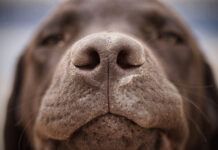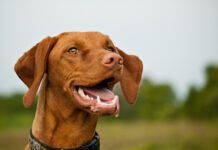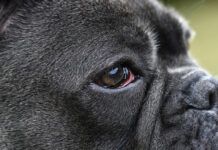Your 6-month-old puppy is off on his left front leg. He seems to worsen with activity, but he is rarely three-legged lame. This may be a sign of dysplastic elbow, or “elbow dyspasia.” (Dysplasia means a developmental abnormality.) Elbow dysplasia is second to osteoarthritis as the most common lameness in dogs.
Elbow dysplasia results from a defect during the final development of the elbow joint in a puppy. The elbow is a complicated joint, involving the meshing of three bones: the humerus (big bone coming down from the shoulder) and the radius and ulna (two smaller bones that make up the forearm). Any change from normal in how these bones meet to form the elbow joint can lead to arthritic changes and corresponding lameness.
Note: Elbow dysplasia has been linked to early spaying/neutering in large dogs, so discuss when to spay or neuter your puppy with your veterinarian.
Can you prevent elbow dysplasia? Certainly, you can reduce the risk in an individual dog by only breeding, or purchasing from, parents with normal elbows per OFA report. Note: Some breed clubs consider Grade I to be basically the same as Normal, but others recommend only breeding dogs with a Normal rating. Selecting parents with normal elbows can reduce the incidence of elbow dysplasia in a breed over time. Keep in mind that this is thought to be a multifactorial problem, so it is not a simple fix. Diet, environment, and genetics are all interacting. In addition, it helps to:
-Keep your young growing dog at a good weight.
-Use an appropriate diet for your growing puppy.
-Regulate exercise for your growing dog. Limit jumping up and down, pounding on hard surfaces, etc. until your dog is fully developed.
-Discuss when to spay or neuter your dog with your veterinarian.
Bones Must Grow Properly
The Orthopedic Foundation for Animals (OFA) defines the degenerative joint disease (DJD) complex known as elbow dysplasia as involving three main areas where a failure for the bones to grow properly may lead to a problem:
- Ununited anconeal process (UAP)
- Osteochondrosis (OCD)
- Fragmented medial coronoid process (FCP)
In most cases, when only DJD is marked on an OFA report (see sidebar), it can be assumed that lesions associated with coronoid process disease are present. This accounts for most elbow dysplasia cases.
Elbow dysplasia is seen in a wide range of dogs, affecting over 79 breeds according to Orthopedic Foundation for Animals (OFA) statistics. The OFA screens dogs for inherited health conditions to help breeders improve genetic health within dog breeds. It is voluntary screening, done with an examination and forms from your own veterinarian who submits the results to the OFA, which then issues a certification score. The statistics can help breeders make better breeding choices to avoid inherited disease. Dogs do not have to be purebred to be part of the OFA and get screened.
The breeds with the highest rate of elbow dysplasia according to OFA statistics are the Chow and Bulldog. Interestingly, Beagles and Pyrenean Shepherds have no recorded cases of elbow dysplasia.
OFA Grades the Joint
If the joint isn’t normal, OFA grades it as the level of changes in the joint. The classifications for elbows are:
- Grade I Elbow Dysplasia:Minimal bone change along anconeal process of ulna (less than 2mm).
- Grade II Elbow Dysplasia: Additional bone proliferation along anconeal process (2-5 mm) and subchondral bone changes (trochlear notch sclerosis).
- Grade III Elbow Dysplasia: Well-developed degenerative joint disease with bone proliferation along anconeal process being greater than 5 mm.
These grades are based on the amount of degenerative joint disease noted on radiographs. The bony degenerative changes are the result of joint defects. It is recommended to do elbow evaluations at 2 years of age. Over time, normal wear and tear on your dog’s elbow joints may lead to some bony arthritis changes, obscuring any genetic developmental problems.
Severe elbow dysplasia can be debilitating, but dogs with mild dysplasia may not show any lameness until later in life. Male dogs are more frequently affected. Both overweight and very active dogs are at risk for joint damage. Estimates of 30% to 80% of dogs will be affected bilaterally, which makes a diagnosis tricky. These dogs may not show the typical head bobbing we commonly associate with front-leg lameness but instead have an overall shortened stride and decreased range of motion. Both legs will show pain upon manipulation. If your dog is lame on one front leg, it is always wise to radiograph the other leg as well in case it is also affected.
With severe elbow dysplasia, the dog may have a swollen front leg at the elbow joint. Bony changes can lead to an almost fused joint, which will feel firm on palpation. In early stages, there may be warmth, fluid buildup, and inflammation, but this will change over time.
Diagnosis of Elbow Dysplasia
Diagnosis starts with a lameness exam, including flexing and extending the elbow joint as well as watching your dog move. Your veterinarian will likely recommend X-rays of the elbow joint. For OFA evaluation, an extreme flexed-joint X-ray view is required, but your veterinarian may take other views as well to determine the extent of the problem. If there is a question about the diagnosis, a CT scan or arthroscopy may be recommended, along with referral a board-certified veterinary surgeon.
Medical treatment can make your dog comfortable, but it won’t really slow down the progression of arthritis. Medical therapy may include painkillers, joint supplements, and rehabilitation plans to strengthen muscles and minimize strain on the joint.
What to Expect With Surgery
Surgery is generally recommended for the best prognosis for quality of life for your dog. The exact surgery done will vary depending on the exact defect.
Any bony or cartilage fragments will need to be removed. This can be done arthroscopically in many cases. If the joint needs to be realigned, more extensive surgery is required.
In rare cases, total elbow replacement may be suggested. There are limited facilities prepared to do replacement surgery, and elbow replacement is associated with potential complications. These include:
- Infections of the surgery site
- Instability of the prosthesis
- Fractures around the prosthesis site
These complications tend to occur early on post operatively, with a rate of 15% complications in the first year. On the positive side, 75% or more dogs who have had elbow replacements are considered successful with a great decrease in pain and ability to resume normal, or near normal, activities.
Postoperative care and rehabilitation are important for elbow dysplasia cases. Your veterinarian will provide you with a full plan, starting with limited activity for healing to take place, and then exercises to gradually build back muscles.
The American College of Veterinary Surgeons emphasizes that surgery is not a cure, stating: “Once arthritis is established it will slowly progress regardless of any treatment. On average, with treatment 85% of cases will show some degree of improvement in lameness and comfort despite progression of arthritis on X-rays. The aim of treatment is to slow the progression of arthritis and prolong the patients’ use of the elbow. Unfortunately elbow dysplasia cannot be cured but it can be well managed, and our patients can have a good long-term prognosis and outcome with a combination of surgical and medical management.”






